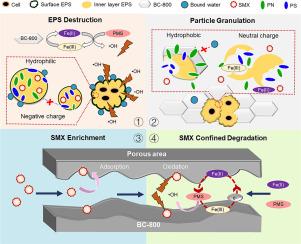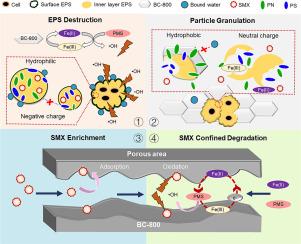Enhanced sludge dewaterability and confined antibiotics degradation in biochar-mediated chemical conditioning through modulating Fe oxidative states distribution and reaction sites in multiphase
IF 11.4
1区 环境科学与生态学
Q1 ENGINEERING, ENVIRONMENTAL
引用次数: 0
Abstract
For antibiotic-enriched waste activated sludge, classical iron-based chemical conditioning significantly enhanced sludge dewaterability. Nevertheless, the intricate constituents within sludge rapidly depleted reactive oxygen species (ROS), leading to challenges such as excessive production of iron sludge and inadequate elimination of antibiotics from sludge. Herein, we proposed an innovative strategy integrating biochar with Fe(II) for peroxymonosulfate (PMS) activation, aiming to enhance both sludge dewaterability and antibiotics elimination simultaneously. Compared to classical chemical conditioning of Fe(II)/PMS, the presence of biochar not only reduced bound water content of sludge from 1.36 g/g DS to 0.97 g/g DS, but also enhanced sulfamethoxazole (SMX) degradation rate constant from 0.015 min-1 to 0.042 min-1. Mechanism studies disclosed the essential roles of biochar in modulating Fe oxidative states distribution and reaction sites in multiphase. Initially, biochar elevated Fe(II)/Fe(III) ratio from 0.38 to 0.78 by abundant carbon defects, which significantly promoted the cumulative concentration of predominant ROS, hydroxyl radicals (•OH), from 4.6 mM to 8.1 mM. Subsequently, EPS underwent destruction by •OH, leading to the liberation of antibiotics and negatively charged polysaccharides (PS), proteins (PN). Secondly, biochar enriched hydrophobic PN with an elevated ratio of PN/PS from 0.92 to 1.50, while the charge neutralization occurred between Fe(II)/Fe(III) and PN, PS, leading to sludge particles granulation. Finally, the mesoporous structure of biochar not only achieved SMX enrichment, but also enhanced the mass transfer of Fe(II)/Fe(III) from sludge aqueous phase to its surface, ensuring that the in-situ generated •OH efficiently targets the locally concentrated SMX. Overall, this work provides a new guidance for developing biochar-mediated chemical conditioning, aiming to enhance the generation and utilization of •OH for antibiotics elimination from sludge.


通过调节多相中铁氧化态的分布和反应场所,提高生物炭介导的化学调理过程中污泥的脱水性和封闭抗生素的降解能力
对于富含抗生素的废弃活性污泥而言,传统的铁基化学调节方法可显著提高污泥的脱水能力。然而,污泥中错综复杂的成分会迅速消耗活性氧(ROS),从而导致铁污泥产量过高、污泥中抗生素去除不充分等问题。在此,我们提出了一种将生物炭与过氧化单硫酸盐(PMS)活化铁(II)相结合的创新策略,旨在同时提高污泥脱水性和抗生素去除率。与传统的 Fe(II)/PMS 化学调节相比,生物炭的存在不仅将污泥的结合水含量从 1.36 g/g DS 降至 0.97 g/g DS,还将磺胺甲噁唑(SMX)的降解速率常数从 0.015 min-1 提高到 0.042 min-1。机理研究揭示了生物炭在多相中调节铁氧化态分布和反应位点的重要作用。起初,生物炭通过丰富的碳缺陷将铁(II)/铁(III)比从 0.38 提高到 0.78,这显著促进了主要 ROS-羟基自由基(-OH)的累积浓度从 4.6 mM 提高到 8.1 mM。随后,EPS 被 -OH 破坏,导致抗生素和带负电荷的多糖(PS)、蛋白质(PN)的释放。其次,生物炭富集了疏水性 PN,PN/PS 的比例从 0.92 升至 1.50,而 Fe(II)/Fe(III)与 PN、PS 之间发生电荷中和,导致污泥颗粒颗粒化。最后,生物炭的介孔结构不仅实现了 SMX 的富集,还增强了 Fe(II)/Fe(III) 从污泥水相到其表面的传质,确保了原位生成的 -OH 有效地针对局部富集的 SMX。总之,这项工作为开发生物炭介导的化学调理提供了新的指导,旨在提高-OH 的生成和利用,从而消除污泥中的抗生素。
本文章由计算机程序翻译,如有差异,请以英文原文为准。
求助全文
约1分钟内获得全文
求助全文
来源期刊

Water Research
环境科学-工程:环境
CiteScore
20.80
自引率
9.40%
发文量
1307
审稿时长
38 days
期刊介绍:
Water Research, along with its open access companion journal Water Research X, serves as a platform for publishing original research papers covering various aspects of the science and technology related to the anthropogenic water cycle, water quality, and its management worldwide. The audience targeted by the journal comprises biologists, chemical engineers, chemists, civil engineers, environmental engineers, limnologists, and microbiologists. The scope of the journal include:
•Treatment processes for water and wastewaters (municipal, agricultural, industrial, and on-site treatment), including resource recovery and residuals management;
•Urban hydrology including sewer systems, stormwater management, and green infrastructure;
•Drinking water treatment and distribution;
•Potable and non-potable water reuse;
•Sanitation, public health, and risk assessment;
•Anaerobic digestion, solid and hazardous waste management, including source characterization and the effects and control of leachates and gaseous emissions;
•Contaminants (chemical, microbial, anthropogenic particles such as nanoparticles or microplastics) and related water quality sensing, monitoring, fate, and assessment;
•Anthropogenic impacts on inland, tidal, coastal and urban waters, focusing on surface and ground waters, and point and non-point sources of pollution;
•Environmental restoration, linked to surface water, groundwater and groundwater remediation;
•Analysis of the interfaces between sediments and water, and between water and atmosphere, focusing specifically on anthropogenic impacts;
•Mathematical modelling, systems analysis, machine learning, and beneficial use of big data related to the anthropogenic water cycle;
•Socio-economic, policy, and regulations studies.
 求助内容:
求助内容: 应助结果提醒方式:
应助结果提醒方式:


